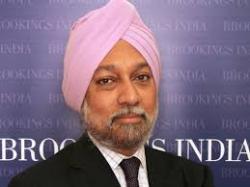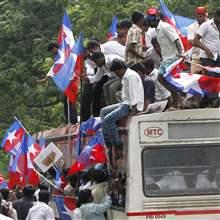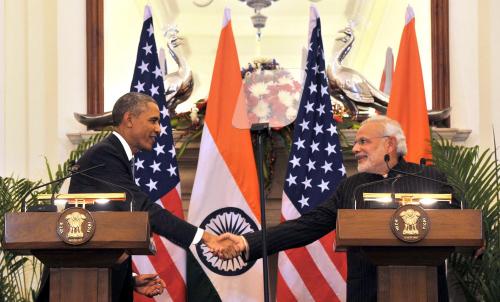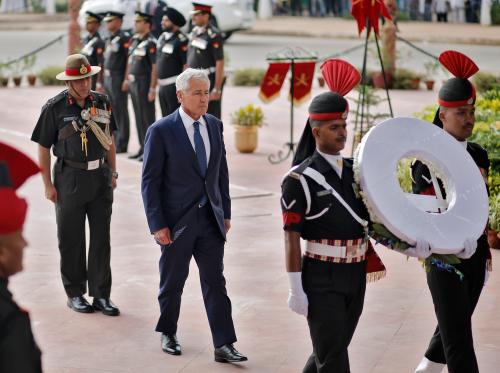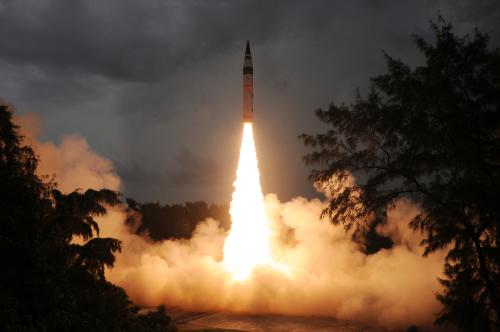Content from the Brookings Institution India Center is now archived. After seven years of an impactful partnership, as of September 11, 2020, Brookings India is now the Centre for Social and Economic Progress, an independent public policy institution based in India.
U.S.-India civil nuclear cooperation, starting with the July 18, 2005 nuclear agreement and culminating in the formal 123-agreement bill approved by the U.S. Congress on September 28, 2008, was expected not only to become a springboard for extensive bilateral nuclear cooperation, including the sale of U.S. reactors to support India’s ambitious nuclear power plans, but was also expected to mark an end to decades-old strategic mistrust between the two biggest democracies. It was also expected to end India’s nuclear isolation and transform the existing global nuclear order – in line with President Barack Obama’s Prague agenda and the nuclear security initiative. Yet, just as that agreement on the historically and politically fraught nuclear issue was seen as opening the door to a fundamentally strengthened U.S.-India relationship, the failure so far to follow through in the civil nuclear area has come to epitomize the bogging down of efforts over the last few years to elevate overall bilateral ties to a new level.
The current impasse in nuclear energy cooperation was discussed during Prime Minister Narendra Modi’s September 2014 visit to Washington. The two sides agreed to establish a Contact Group “to realize their shared goal of delivering electricity from U.S.-built nuclear power plants to India”. Under the supervision of the top leadership, the Contact Group, consisting of U.S. and Indian government officials and nuclear industry representatives, has met more than twice in preparation for President Obama’s trip to New Delhi in January 2015 in an effort to clear hurdles to the building of U.S. nuclear power plants in India.
While Westinghouse and General Electric have each received India’s blessing to build two nuclear power reactors at designated sites – in Mithi Virdi in Gujarat and Kovvada in Andhra Pradesh respectively – and Westinghouse and the Nuclear Power Corporation of India Limited (NPCIL) have engaged in preliminary commercial negotiations, the path ahead to constructing those reactors will remain blocked unless two difficult issues can be resolved: (1) liability for nuclear reactor accidents and (2) arrangements for tracking and accounting of U.S.-supplied nuclear materials in India.
India’s Civil Liability for Nuclear Damage (CLND) Act of 2010 appears to allow lawsuits to be brought against suppliers for nuclear reactor accidents, which the U.S. Government and U.S. companies, as well as many governments and companies around the world, regard as inconsistent with existing international norms – particularly the Convention for Supplementary Compensation for Nuclear Damage – that channel liability to nuclear plant operators. Despite protests from foreign governments and reactor vendors as well as from Indian equipment suppliers, the Indian government – reflecting domestic sensitivity over the 1984 Bhopal disaster, post-Chernobyl and post-Fukushima concern, and resistance to giving in to foreign pressure – has refused to alter the liability law.
In recent months, India has explored ways to overcome the liability impasse without changing its law. One element of a solution could be the creation of an insurance pool that would indemnify suppliers against liability. India’s state-run reinsurer, General Insurance Corporation (GIC) Re, is currently developing a proposal for such an insurance fund and a related risk-informed premium to which suppliers and operators would contribute. Foreign private companies have so far been non-committal about this idea and presumably would find it acceptable only if they could recoup their contribution to the fund by charging more for their reactor supplies. Indian private companies are equally circumspect about the viability of an insurance pool.
A second element of a possible solution could be an authoritative clarification of a key provision of the liability law (section 46), which the Indian government interprets as not placing suppliers in jeopardy. To alleviate suppliers’ concerns, such a clarification would have to be clearly seen as not subject to challenge by Indian courts.
Perhaps more difficult than the liability issue is the question of tracking and accounting of nuclear material supplied by the United States or produced in U.S.-supplied reactors. The United States maintains that the U.S.-India civil nuclear agreement calls for an “administrative arrangement” that would provide necessary information regarding the whereabouts of those nuclear materials. Washington argues that unless it knows where the materials are located, it will not be able to exercise the consent rights or meet the physical security requirements provided for in the agreement and, as a consequence, the U.S. Nuclear Regulatory Commission will probably not be willing to issue the licenses needed to go forward with nuclear reactor sales to India. The United States points out that it has tracking and accounting arrangements with most of its nuclear cooperation partners, including Euratom and Japan.
India has been unwilling to accept such an arrangement. It argues that tracking and accounting for nuclear materials “by flag” (i.e., by nationality) is not required by the U.S.-India agreement. It maintains that all nuclear material subject to the U.S.-India agreement will be covered by International Atomic Energy Agency (IAEA) safeguards and that the Agency’s assurance that all the material is accounted for and devoted to peaceful purposes should be sufficient for the U.S. (as it was sufficient for Canada, which initially sought the kind of arrangement that Washington wants).
India objects to the additional expense and effort that would be required to set up and implement a tracking and accounting mechanism for U.S.-flagged material. Sensitive to perceived infringements of its nuclear sovereignty, it presumably also harbors resentment toward the greater intrusiveness that the United States requires of its nuclear cooperation partners.
If the two sides want U.S. reactor projects to proceed, they will need to find a compromise on this issue, with the U.S. settling for less detailed information than it would prefer and India recognizing that greater transparency is not as onerous and is consistent with widespread international practice, including among advanced nuclear energy powers.
Resolving the liability and tracking issues would not only remove key obstacles to implementing the U.S.-India civil nuclear agreement, it would also give a boost to the overall bilateral relationship. Given the mutual suspicions that persist in the bureaucracies of both countries, it is essential that agreement be pursued at the highest levels, which is why civil nuclear cooperation will remain on the summit agenda.
However, with more expert-level preparatory work required on both liability and tracking, it will not be possible to resolve outstanding civil nuclear issues at the upcoming Obama-Modi meeting in January. Still, the leaders can expedite the process by giving their governments guidance for reaching a solution. On the liability issue, the Contact Group should be directed to develop an insurance fund acceptable to suppliers, operators, and other key stakeholders and to come up with an authoritative clarification of India’s liability law that would be seen as reliably protecting suppliers from lawsuits. On the issue of tracking and accounting, the Contact Group should be instructed to draft an administrative arrangement that would meet U.S. legal requirements without placing an undue burden on India.
A separate but politically-related issue likely to be raised at the summit is India’s membership in the multilateral export control groups, especially the Nuclear Suppliers Group (NSG). Since 2010, the United States has been committed to supporting and facilitating India’s membership in these groups. President Obama reaffirmed that commitment in the Joint Statement issued at the Washington summit in September 2014: “The President affirmed that India meets MTCR [Missile Technology Control Regime] requirements and is ready for membership in the NSG. He supported India’s early application and eventual membership in all four regimes.”
India has made good progress in harmonizing its export controls with the guidelines and control lists of the four multilateral groups. But membership in the groups requires a consensus among its members and, in the NSG in particular, there is no consensus on admitting India. The United States has urged India to play a more active diplomatic role on its own behalf in persuading holdouts to support its candidacy, while India has pressed Washington to pursue the kind of all-out, high-level campaign used by the Bush Administration to gain a consensus in the NSG to permit nuclear cooperation with India even though it had not joined the Nuclear Non-Proliferation Treaty.
One approach might be to seek membership in the first instance of the multilateral groups other than the NSG where there is greater consensus on India’s entry. Among them the MTCR, the Wassenaar Arrangement on Export Control for Conventional Arms and Dual-Use Goods and Technologies, and the Australia Group (that aims to curb exports that might contribute to chemical and biological weapon programs) are worth pursuing. India’s bid for membership of these three groups might also contribute to building consensus for its membership of the NSG.
Although neither side has directly linked the membership issue to the implementation of the U.S.-India civil nuclear agreement, it is possible that a reinvigoration of the effort to gain Indian entry into the multilateral groups could facilitate solutions to the issues impeding bilateral nuclear cooperation. On the other hand, an all-out effort by the U.S. might be more forthcoming if New Delhi was able to show significant movement on the civil nuclear deal. That in turn would provide a much-needed fillip to the bilateral strategic relationship.

